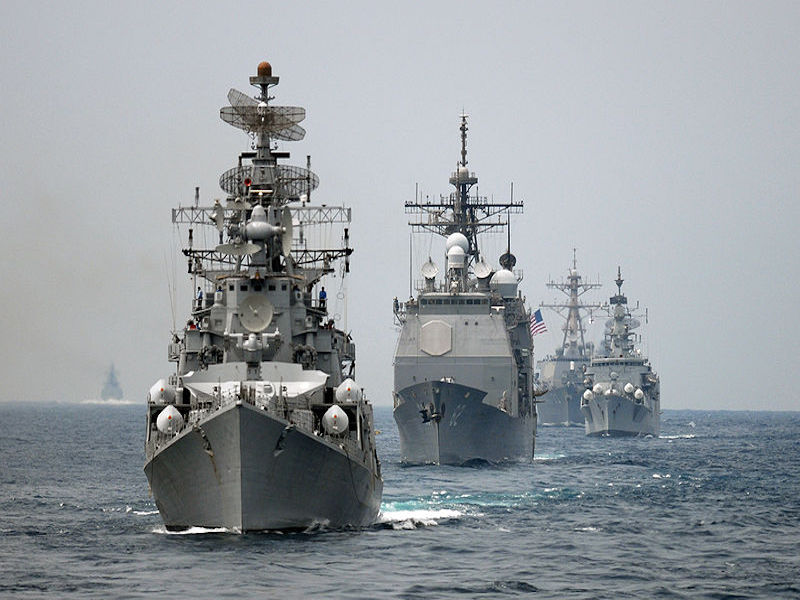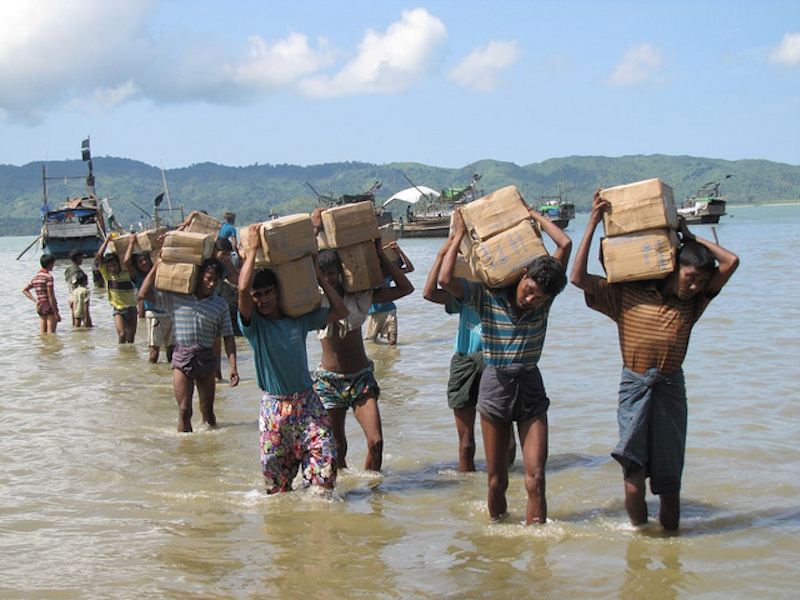As is certain with every time a seismic shift in global power occurs, there is a new global hotspot for military conflict, and a playground for world powers to build up their military prowess. The United States has retreated from the global stage, Russia has actively entered the Middle Eastern fray, China has dominantly asserted itself in the South China Sea, and middle powers now vie for whatever power they can grasp on to, with one of the most hotly contested regions now being the Indian Ocean.
When China began its assertive actions in the South China Sea, it was a compartmentalized issue that the United States could undoubtedly push back against alongside its allies in the ASEAN countries. When Egypt gave the Red Sea Islands of Tiran and Sanafir to Saudi Arabia, it was viewed through the lens of Middle Eastern allegiances. Djibouti? That was just a playground for the military bases of world powers. Now? The picture is clearer, and the sparsely occupied Indian Ocean has the capacity to see one of the most congested and sizeable military build-ups in the world, which in the process could create numerous untold risks.
The Indian Ocean is a vital trade route for a very large portion of the world’s global trade. Nearly 40% of the world’s offshore petroleum is produced in the Indian Ocean, which is also rich in rich mineral deposits and fisheries. On one side, the busiest entrance to the Indian Ocean is through the South China Sea and the Straits of Malacca, which China is now dominantly positioning itself near. On the other end, the closest route towards Europe and into the Mediterranean Sea is through the Egyptian operated Suez Canal – and if the hope is to bypass going around the continent of Africa – the Bab-Al-Mandab straits.
In an era of shifting power structures in the world, whoever controls these strategic waterways, and whoever is able to safeguard the passage of global trade through these straits, holds an immense amount of power. And so, the race has begun. The earliest forewarnings of these escalations were China’s procurement of Sri Lanka’s deep-water Hambantota port – attained via predatory lending practices that in effect gives it no choice but to acquiesce to China’s demands – for a 99-year lease as a part of the One Belt, One Road Initiative, about which India, in particular, is not too pleased. The predatory lending practices have become a signature move in China’s quest for influence.
While Sri Lanka has promised it’s northern Indian neighbour that the port will not be used for military purposes, this is not something it can guarantee, and India has begun to view China’s “string of pearls” strategy as a means of encircling it and achieving regional supremacy. In addition to Sri Lanka, China also owns and operates a port in Tanzania, in the important East African region.
As a means of countering China’s actions, Indian Prime Minister Narendra Modi is peddling his Security And Growth For All In The Region (SAGAR) strategy. This strategy is common sense for India, since 95% of its trade by volume, and 70% by value, passes through the Indian Ocean. Although late in attempting to adjust balance of power, Modi visited Oman earlier this year and signed agreements with the Sultanate to allow India access to Oman’s naval facilities on the straits of Hormuz, the main access point to the Persian Gulf – another extremely strategic and contentious area of the world at the edge of the Indian Ocean. While bolstering his country’s position on the western part of the Indian Ocean is important, it would be futile if that meant China’s complete control over the eastern parts, and especially Singapore’s Straits of Malacca. This has led Modi to sign pacts with Singapore last November, in order to boost India’s access to the Changi naval base.
French President Emmanuel Macron visited New Delhi on March 10th and renewed the French commitment to defence and security between the two nations, as well as a strategy to share intelligence and have the ability for both of their respective navies to use each other’s military bases. Another important step taken was for agreements to use their space agencies to conduct joint monitoring of the maritime area. Macron stated on his visit that the “Pacific or Indian Ocean[s] cannot be places for hegemonic powers.”
A recent flashpoint in developments concerns the little but now inevitably strategic archipelago of Islands called the Maldives. Historically in India’s ‘backyard’ when it comes to foreign policy and political allegiances, India now feels extensive pressure coming from China towards the island nation. China bought several islets from the Maldives, which cannot even consider repaying its 1.2 billion dollar debt to China, and has come out as the only country in support of the embattled authoritarian president, Abdulla Yameen, who came to power in 2013. In an unprecedented move, Beijing issued an open threat to New Delhi, seeking to deter it from militarily intervening in the island’s ongoing political chaos, as it once did in 1988 to foil a coup attempt against the democratically elected president, and thus reinforcing India’s claim to be the region’s peacekeeper.
As the Maldivian political crisis unfolded, India’s top diplomat, former foreign secretary S. Jaishankar made an unannounced visit to the strategic Indian Ocean Island of Seychelles, hoping to develop military infrastructure on Assumption Island, just 1700 kilometres east of mainland Africa in Djibouti, where China currently maintains a military base, it’s first outside its own borders. Modi previously visited Seychelles in 2015, on the same tour that took him to another island nation, Mauritius, and signed similar agreements for military infrastructure on Agalega Island. The Seychelles opposition, has, however, managed to stop the military base from being built, declaring that the island nation should not become a place for geopolitical rivalries.
For China, this is a matter of advancing a front in the Indian Ocean in the same way that the Trans-Himalayan front was opened under the leadership of Mao Zedong when he annexed Tibet, the historical buffer between the two Asian powers. For India, this encirclement has become unacceptable. If there was any doubt before, it is China’s remarkable pace of investment in Pakistan – India’s arch nemesis – and especially the Guadar port that China is funding and has ownership of, that was probably the move that officially crossed the line. The port has the capability of providing exactly the kind of open-trade source that had previously been missing for the landlocked central Asian countries. Seeing that as an unacceptable strategic advantage for China and Pakistan to hold all by themselves, India countered with the Chabahar port in Iran, which is expected to be a key transit route between India, Iran, and Afghanistan.
Nevertheless, China is not done with its expansion, and needs deep-sea water ports as well on the Bay of Bengal, on the eastern side of the Indian peninsula. Therein come the Chinese majority-owned Kyauk Pyu port and the Indian funded river-sea-land link, both in Myanmar’s Rakhine state. China, and India too, have been strongly attempting to defend Myanmar against international sanctions and condemnation during its ethnic cleansing and genocide of the Rohingya minority in Rakhine state, where Kyauk Pyu, and the Indian project lie. This is mostly due to the fact that their Indian Ocean plans depend on Myanmar’s cooperation. In this instance, the fear of risking investments in the Indian Ocean has already caused tens of thousands of deaths and created hundreds of thousands of refugees. The Rohingya were already one of the most vulnerable minorities in the world.
As the world watches the events occurring in the Indian Ocean, other midsize powers have taken note, and are now actively attempting to place themselves in positions of negotiating power alongside India and China, thus upholding their trade routes for decades to come. The new players, Saudi Arabia, the United Arab Emirates and Turkey are racing to build naval and military bases on the horn of Africa. The Saudis are hoping for a base in Djibouti, alongside other global powers, while the UAE has a base in Eritrea, and has intentionally sought to sow division between northern and southern Yemen in the hopes of acquiring a foothold on the Socotra Islands. Turkey, meanwhile, currently holds its largest foreign military base in Mogadishu, and has recently signed agreements to either approve or upgrade military bases on the Sudanese Red Sea Island of Suakin and Qatar, in the Persian Gulf.
The intense pace of military build-ups in this area of the world is having unintended consequences that are recklessly not being accounted for, such as the UAE and Saudi Arabian rivalry with Turkey and Qatar fuelling the rivalry between Egypt, Sudan and Ethiopia on the Nile River, which has the potential to spark a total war between the three nations; the river is an existential resource for all three nations. The Indian Ocean military race is now also influencing the other infamous Middle Eastern rivalry between Saudi Arabia and Iran, as India builds the port in Chabahar and Saudi Arabia moves closer to Pakistan. Saudi Arabia has even gone as far as increasing its ties to the Comoros Island and the Maldives, even pushing the Maldivian government to cut ties with Qatar at the onset of the Gulf crisis on June 5th last year.
Australia, France, Japan, and Indonesia are also expected to become more involved in the region, in order to preserve their own trade routes and interests. As long as there is no overarching consensus on the protection of ocean-based trade and the prohibition of the militarization of ports on the Indian Ocean, untenable power structures could begin to engulf the rest of the extended region and the world.
Photo: The Indian ship Rajput class destroyer INS Rana (D 52) leads the passing exercise formation (2008), by U.S. Navy NewsStand via Wikimedia. Public Domain.
Disclaimer: Any views or opinions expressed in articles are solely those of the authors
and do not necessarily represent the views of the NATO Association of Canada.




